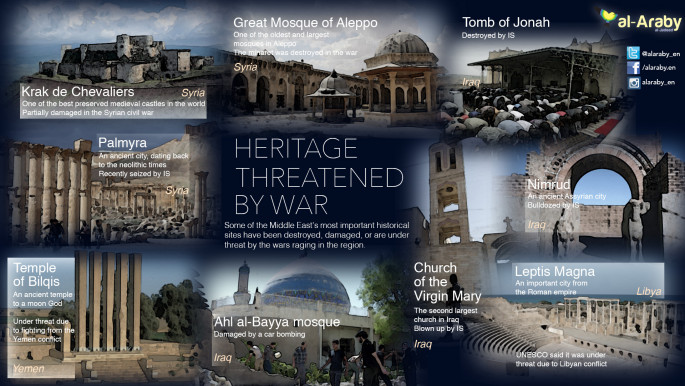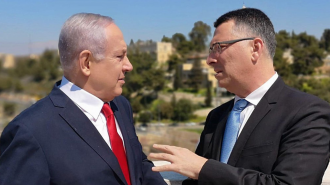Islamic State advance threatens Palmyra's ruins again
Islamic State advance threatens Palmyra's ruins again
The ultra-radical jihadists are on the move again in eastern Syria, with gradual advances against regime forces there including in Palmyra threatening dire consequences for its people and ancient ruins.
3 min read
The IS threat to the ancient city and its ruins is far from over [AFP]
The Islamic State seized several positions on the outskirts of Palmyra on Sunday in ongoing battles with Syrian regime forces, threatening once again the ancient city that was re-captured by the regime in March in a much touted victory against IS.
A Syrian army major general was killed in the battles.
IS seized several positions near the hill of Mohammad bin Ali, 4 km north-west of Palmyra, said the Local Coordination Committee in Palmyra, as Syrian regime warplanes bombed the area.
Four Russian helicopters and twenty trucks carrying missiles were also destroyed inside the Tayfour airbase near Palmyra on Sunday, claimed an IS-affiliated news outlet said. The report was later confirmed by Suhaib al-Ali, official spokesman for the rebel Homs Liberation Movement.
IS took two hills north of Palmyra and seized rocket-firing platforms, Ali told The New Arab.
Around 20 regime soldiers were killed in the ongoing battles, which are now concentrated on the edge of the city, after roads leading to Palmyra were cut off by IS, he added.
Pro-regime outlets, meanwhile, said a senior officer in the army was killed in the fighting in Palmyra.
The Hama News website named him as Maj. Gen. Mohammad Jourieh (Abu Wael), from the village of Deir al-Salib in the Hama province.
Meanwhile, at least 18 IS militants and 7 regime soldiers were killed near al-Shaer gas field in the eastern Homs countryside, said the Syrian Observatory for Human Rights.
IS's advances near Palmyra, Deir ez-Zor and the strategic gas field in eastern Homs province pose a new threat to the ancient city.
In May 2015, IS took over Palmyra after fierce battles with Syrian regime army forces.
In August 2015, satellite images confirmed the destruction of the Baal Shamin temple in Syria’s ancient city of Palmyra, according to the United Nations, which condemned IS claims of destroying the temple.
The UN slammed the destruction of the temple as a “war crime,” and the act has raised concerns for the rest of the UNESCO World Heritage site.
IS later published images showing militants placing explosives into the temple in order to destroy the ancient monuments, which they believe are idolatry and defy their interpretation of Islam.
A Syrian army major general was killed in the battles.
IS seized several positions near the hill of Mohammad bin Ali, 4 km north-west of Palmyra, said the Local Coordination Committee in Palmyra, as Syrian regime warplanes bombed the area.
Four Russian helicopters and twenty trucks carrying missiles were also destroyed inside the Tayfour airbase near Palmyra on Sunday, claimed an IS-affiliated news outlet said. The report was later confirmed by Suhaib al-Ali, official spokesman for the rebel Homs Liberation Movement.
IS took two hills north of Palmyra and seized rocket-firing platforms, Ali told The New Arab.
Around 20 regime soldiers were killed in the ongoing battles, which are now concentrated on the edge of the city, after roads leading to Palmyra were cut off by IS, he added.
 |
IS's advances near Palmyra, Deir ez-Zor and the strategic gas field in eastern Homs province pose a new threat to the ancient city |  |
The Hama News website named him as Maj. Gen. Mohammad Jourieh (Abu Wael), from the village of Deir al-Salib in the Hama province.
Meanwhile, at least 18 IS militants and 7 regime soldiers were killed near al-Shaer gas field in the eastern Homs countryside, said the Syrian Observatory for Human Rights.
IS's advances near Palmyra, Deir ez-Zor and the strategic gas field in eastern Homs province pose a new threat to the ancient city.
 |
| Click to enlarge |
In May 2015, IS took over Palmyra after fierce battles with Syrian regime army forces.
In August 2015, satellite images confirmed the destruction of the Baal Shamin temple in Syria’s ancient city of Palmyra, according to the United Nations, which condemned IS claims of destroying the temple.
The UN slammed the destruction of the temple as a “war crime,” and the act has raised concerns for the rest of the UNESCO World Heritage site.
IS later published images showing militants placing explosives into the temple in order to destroy the ancient monuments, which they believe are idolatry and defy their interpretation of Islam.
Syria’s ancient city of Palmyra was recaptured from the jihadists by Syrian army forces with Russian air cover in March this year, in a much-touted victory by the regime.
IS extremists retreated towards the northern villages of Palmyra and its eastern outskirts at the time. The group’s leadership later ordered its militants to withdraw towards its main bastion of Raqqa, northeastern Syria.
IS extremists retreated towards the northern villages of Palmyra and its eastern outskirts at the time. The group’s leadership later ordered its militants to withdraw towards its main bastion of Raqqa, northeastern Syria.

![Palestinians mourned the victims of an Israeli strike on Deir al-Balah [Getty]](/sites/default/files/styles/image_684x385/public/2024-11/GettyImages-2182362043.jpg?h=199d8c1f&itok=xSHZFbmc)


![The law could be enforced against teachers without prior notice [Getty]](/sites/default/files/styles/image_684x385/public/2178740715.jpeg?h=a5f2f23a&itok=hnqrCS4x)
 Follow the Middle East's top stories in English at The New Arab on Google News
Follow the Middle East's top stories in English at The New Arab on Google News

![Palestinian journalists in West Bank [Getty]](/sites/default/files/styles/image_330x185/public/2167088057.jpeg?h=a5f2f23a&itok=smdkN-46)
